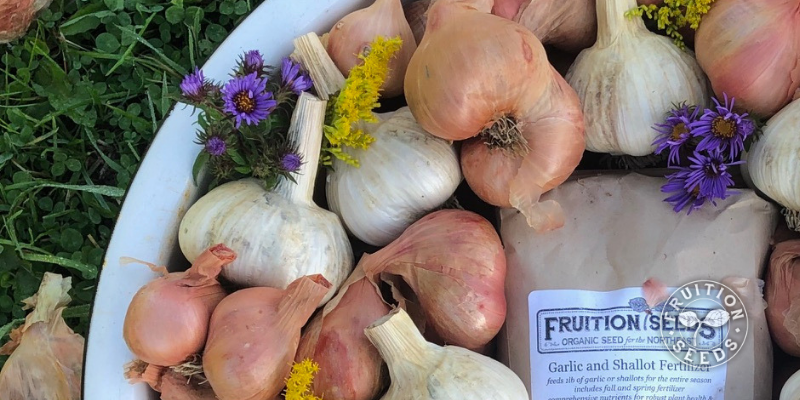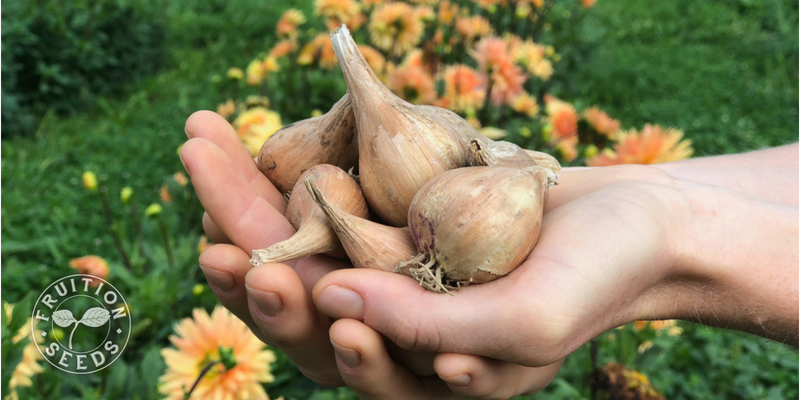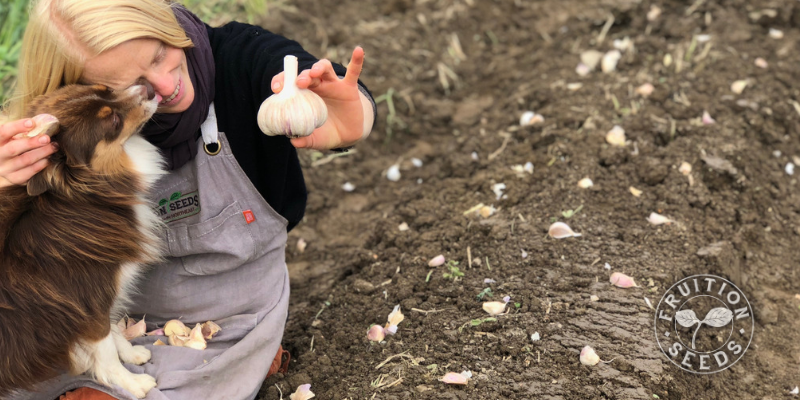Garlic and shallots are two of the easiest and most rewarding crops to grow, though they’re far from foolproof. We’ve grown garlic here in the Finger Lakes for over three decades and here are the keys to surrounding yourself with abundance!
1. Choose the Best Garlic & Shallots to Plant
It’s vital to sow the healthiest ‘seed’ stock bulbs you can source; culinary bulbs are often smaller as well as not assured to be disease as well as nematode-free. Organic bulbs grow best in the widest diversity of conditions. We love to share ours here and if you’re saving your own ‘seed,’ sow only the largest bulbs — indeed, the ones you want to eat most!
Biggest Mistake: Planting anything but the biggest and healthiest organic garlic and shallot bulbs you can find.
Why? There is a direct relationship between the size of bulbs and cloves you plant the size of the bulbs and cloves you’ll harvest. It’s not often true, but in the case of garlic and shallot ‘seed stock,’ bigger truly is better, as long as they’re still healthy and especially if they’re organic.
Easy Solution: Don’t skimp! Ask your local organic growers if they have any seed stock they’ll be willing to sell you. We grow tens of thousands of gorgeous organic seed-stock bulbs of both garlic and shallots of many different varieties, all well-adapted to our short seasons. You’ll find them at www.fruitionseeds.com.
2. When to Plant Garlic & Shallots
Garlic is planted in fall, allowing the cold to divide each clove into the bulb to come. Sowing 2 to 4 weeks after fall frost is ideal. Here in western New York, we plant between late September to early November, though we’ve helped friends plant during a January thaw and their harvest was marvelous! Earlier plantings establish robust roots growing abundant bulbs the following summer. Leaves rising above mulch in fall will die back in winter, ready to emerge strong in early spring.
Biggest Mistake: Planting too early without mulch
Why? Garlic establishes its root system before sending up a green shoot. Planted too early, the green shoot can rise several inches, acting as a straw over the winter to draw water from the clove, potentially desiccating and killing the clove, especially if there is no mulch.
Easy Solution: Plant between late September and early November with plenty of mulch.
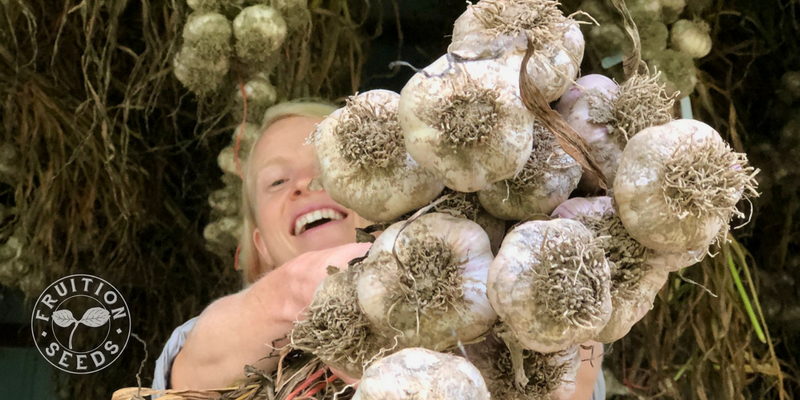
It’s best to err on the side of planting late, rather than too early.
3. How to Prepare Soil for Garlic & Shallots
We till the soil for our garlic bed as close to planting as possible, which can be tricky in the cool, wet soils of autumn. Before we work the soil, we add compost as well as Fruition’s organic garlic & shallot fertilizer for full-spectrum, slow-release nutrition for the soil as well as the crop. Matthew has been perfecting our amendments for garlic & shallots over the years. In 2019, over 95% of the 10,000+ bulbs we grew were seed stock quality; there are many variables, but we’re pretty confident our blend tips the balance.
Biggest Mistake: Not enough fertility added or too much nitrogen added.
Why? Garlic is a ‘heavy feeder,’ so it will not grow large if nutrients are lacking. If its fertility is too nitrogen-rich, however, garlic will focus on vegetative growth, resulting in large leaves above small bulbs. Excess nitrogen also decreases storage life.
Easy Solution: Add rich, well-balanced compost as you prepare your soil as well as our organic slow-release fertilizer for robust soil and plant health as well as abundance to harvest.
Spread and incorporate soil amendments prior to planting. We add compost as well as slow-release, organic granular fertilizer to nourish the soil as well as our garlic in the seasons to come.
4. How to Plant Garlic & Shallots
First things first! Break each bulb into individual cloves and plant each clove tip up and root plate down.
Common Mistake: Planting cloves upside down.
Why? Garlic will only grow roots and shoots from specific places in its clove. When planted upside down, the shoot will go down and force it’s way to the sky despite, making way more work for your garlic to thrive. This also makes it more challenging to harvest, cure and store your garlic.
Easy Solution: watch our tutorial and plant tip up!
Sow both garlic and shallots root down, tip up.
5. Optimum Garlic & Shallot Spacing
Garlic is ideally planted with six inches between cloves, both in and between rows. We give a little more space, sowing with eight-inch centers, because we want to limit competition between plants both above and below the ground.
Common Mistake: Planting too close.
Why? Too close, garlic plants will compete with each other, to their detriment. Their roots compete for the same, finite nutrients. Leaves overlap, competing for sunlight.
Easy Solution: Bring a yardstick or some other measurement tool to the garden, helping keep you on-point, not too close or too far!
Plant your garlic with at least six inches between cloves. We plant on a staggered grid, three rows per bed.
6. How Deep to Plant Garlic & Shallots
Planting depth makes all the difference. At a minimum, sow each clove three inches deep and then be sure to spread six inches of mulch or more. If you’re not planning to mulch, sow at least five inches deep.
Common Mistake: Not planting deep enough.
Why? Planted in fall and not growing rapidly until spring, garlic experiences the most dramatic freeze-thaw frost heaving of the season, bringing each clove to the surface if they’re not deep enough. Garlic will tolerate impressively cold temperatures but quickly succumbs to desiccating winter winds at the soils’ surface.
Easy Solution: Work soil well, so it’s easy to plant as deep as you need.
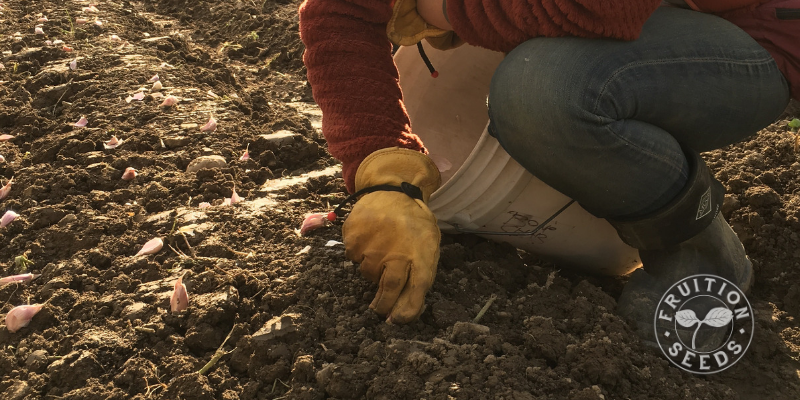
If your soil is freshly worked and not too wet, planting three to five inches deep is easy just with your hands. A trowel is perfect to get a few extra inches of easy depth in denser soils.
7. Garlic & Shallots: To mulch or not to mulch?
Until recently, I’ve always planted garlic and immediately spread six inches (often more!) of straw or shredded leaf mulch to cover. These last few years we’ve been experimenting with other techniques, which have a lot of merit. My favorite mulches are straw, grass clippings, deciduous leaves sent through a chipper/shredder and, believe it or not, moldy hay.
Common Mistake: Not mulching if you don’t always weed thoroughly or on-time. Mulching too little when you do mulch, resulting in more work and more weeds.
Why? Garlic is only an easy crop if you manage it more or less perfectly. It can easily become weedy, whether you mulch or not. The trick with mulch: be sure you’re adding a lot, knowing it will decompose and condense, and be prepared to hand-weed a bit and add several inches more mulch once and often twice in spring.
Easy Solution: Spread six inches of mulch or more as soon as you sow, spreading more in spring as needed.
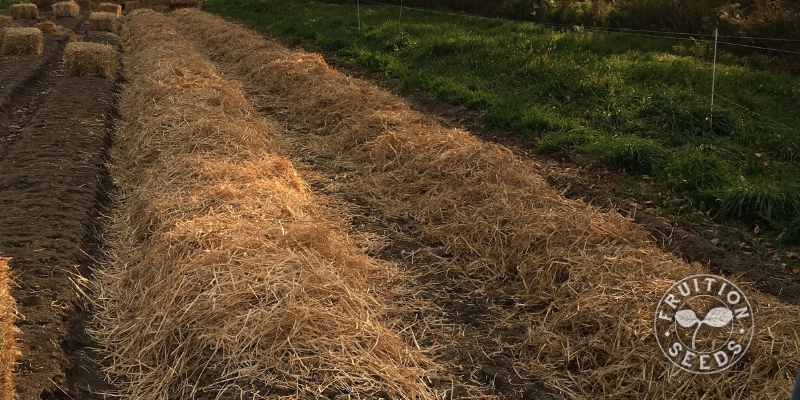
Spread six inches of mulch or more as quick as you can after planting. Have plenty of mulch on-hand to add more in spring.
Friends, I’m delighted you’re planting garlic this season!
Planting garlic is one of the final moments in the garden we enjoy each season, a radical act of faith that even as one season ends, another begins. Garlic is a living link between seasons, between generations. As are you.
Happy Planting!
Sow Seeds & Sing Songs,

and the Many Beings of Fruition
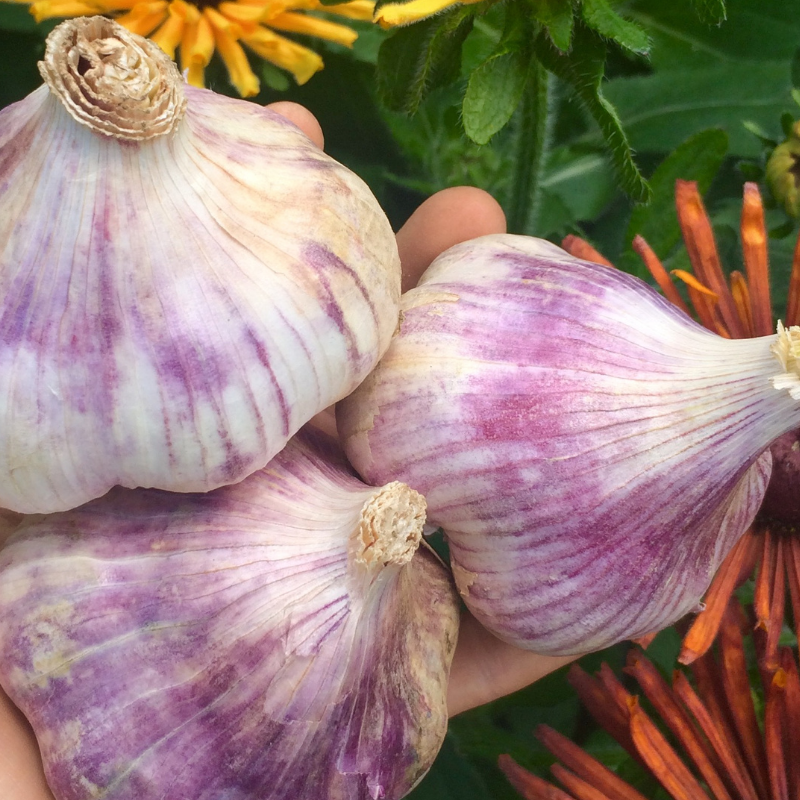
Enjoy Fruition's Course...
Growing
Garlic & Shallots
Organically!
Fruition’s free online course shares dozens of video tutorials to surround you with abundance for seasons to come.
We look so forward to joining you on the journey!

